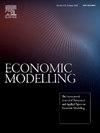秘鲁外部冲击的时变传导:重新评估货币政策的作用
IF 4.7
2区 经济学
Q1 ECONOMICS
引用次数: 0
摘要
本文分析了过去二十年来外部冲击对秘鲁通胀、产出和利率的传导是如何演变的。虽然文献强调了新兴市场贸易条件和全球金融冲击的相关性,但对这些传导机制如何随时间变化的关注有限。利用1998年至2019年的季度数据,分析采用具有随机波动率和混合创新的时变参数VAR模型,以确定三个关键区块的变化:自回归系数、冲击方差和同期响应。结果表明,在2002年采用通货膨胀目标制之后,货币政策冲击的波动性显著下降,同时通货膨胀对外部冲击的敏感性也发生了变化——受国际利率的影响而减弱,受中国产出增长的影响而增强。这些模式反映了货币政策可信度的提高和贸易风险敞口的转变。鲁棒性练习确认了跨可选规范的主要发现的稳定性。本文章由计算机程序翻译,如有差异,请以英文原文为准。
Time-varying transmission of external shocks in Peru: Reassessing the role of monetary policy
This paper analyzes how the transmission of external shocks to inflation, output, and interest rates in Peru has evolved over the past two decades. Although the literature has emphasized the relevance of terms-of-trade and global financial shocks for emerging markets, limited attention has been paid to how these transmission mechanisms change over time. Using quarterly data from 1998 to 2019, the analysis employs a time-varying parameter VAR model with stochastic volatility and mixture innovations to identify changes in three key blocks: autoregressive coefficients, shock variances, and contemporaneous responses. The results indicate a marked decline in the volatility of monetary policy shocks following the adoption of inflation targeting in 2002, along with a shift in inflation’s sensitivity to external shocks—weakening in response to the international interest rate and strengthening in response to Chinese output growth. These patterns reflect improvements in monetary policy credibility and shifts in trade exposure. Robustness exercises confirm the stability of the main findings across alternative specifications.
求助全文
通过发布文献求助,成功后即可免费获取论文全文。
去求助
来源期刊

Economic Modelling
ECONOMICS-
CiteScore
8.00
自引率
10.60%
发文量
295
期刊介绍:
Economic Modelling fills a major gap in the economics literature, providing a single source of both theoretical and applied papers on economic modelling. The journal prime objective is to provide an international review of the state-of-the-art in economic modelling. Economic Modelling publishes the complete versions of many large-scale models of industrially advanced economies which have been developed for policy analysis. Examples are the Bank of England Model and the US Federal Reserve Board Model which had hitherto been unpublished. As individual models are revised and updated, the journal publishes subsequent papers dealing with these revisions, so keeping its readers as up to date as possible.
 求助内容:
求助内容: 应助结果提醒方式:
应助结果提醒方式:


